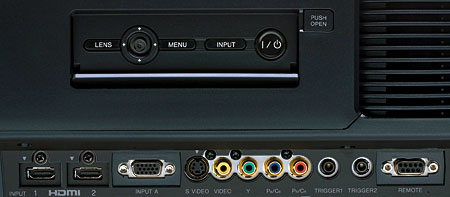Sony BRAVIA VPL-VW70 SXRD Projector
 Price: $8,000 At A Glance: Superb contrast and black levels • Excellent color • Unique adjustments
Price: $8,000 At A Glance: Superb contrast and black levels • Excellent color • Unique adjustments
It should be obvious that the cost of a great home theater projector keeps coming down. At $8,000, Sony’s new VPL-VW70 includes many features that distinguished its earlier, more expensive designs, improves on them in some important respects (particularly black levels), and brings a few new wrinkles of its own to the party.

Description
The large, relatively heavy Sony is easily the looker of this group. If you replaced its lens with a laser cannon and added a bridge bubble on top, its curvy, sci-fi-inspired shape wouldn’t be out of place swooping overhead at the beginning of Galaxy Quest II: The Wrath of Melmac.
The VPL-VW70’s SXRD (Silicon X-tal Reflective Display) imaging chip is Sony’s variation of Liquid Crystal on Silicon (LCOS). Its 1.6x zoom lens will fill a 100-inch-diagonal (87-inch-wide) 16:9 screen from distances ranging from (approximately) 10 to 15.3 feet. It offers motorized zoom, focus, and shift (horizontal and vertical). You can make these adjustments while viewing a special lens-adjustment test pattern, or deselect it in the menu and view it with any source material.
As with all multiple-chip projectors, the Sony’s three imaging chips must be precisely aligned to get the sharpest picture. The VPL-VW70 incorporates a sophisticated panel-alignment feature that can (electronically) trim the position of each of the three colors, either over the entire screen or in zones. It works on a fraction of a pixel level, not just on full pixels.
The projector’s on-chassis controls are located behind a panel on the side of the case. The inputs and power connection are below it, on the same side. Apart from the slight inconvenience of side-mounted jacks, they are so deeply recessed that it’s hard to access them in a tabletop installation without raising that side of the projector.

The remote control is the best of the group, with clearly legible labels on its large, fully backlit buttons. It has direct access to many of the controls, including Sharpness, Brightness, Contrast, and the Picture Modes. You can use the menu to choose direct input access or cycle through your inputs. If you choose the latter, you can delete any unused inputs.
The Sony includes the usual picture adjustments, with six different, individually adjustable Picture modes. You can also put in different video settings for each input, and for each source resolution as well.
Real Color Processing (RCP) allows adjustment for each of the primary and secondary colors. Sony’s manual suggests using this to taste, but I recommend that you leave it alone, even if you have sophisticated test tools and the ability to use them. RCP has been available in other Sony products, and it has always struck me as ergonomically challenged. I would welcome a more straightforward design, with clearly labeled and effective saturation, hue, and intensity controls for each color (red, green, blue, cyan, magenta, and yellow). Fortunately, Sony offers a color gamut that is reasonably accurate to begin with (in the Normal Color Space setting—Wide is oversaturated). I left RCP off.
Gamma controls adjust the intensity of the image in the mid-brightness region. The VPL-VW70 offers a wider range of Gamma Correction settings than those found on Sony’s earlier flagship projectors. It also has a supplied Image Director3 PC program that can produce an infinite variety of personal gamma adjustments through a computer interface. I found the standard Gamma Correction settings to be more than adequate, and I generally preferred Gamma 4 or Gamma 6.
- Log in or register to post comments





























































